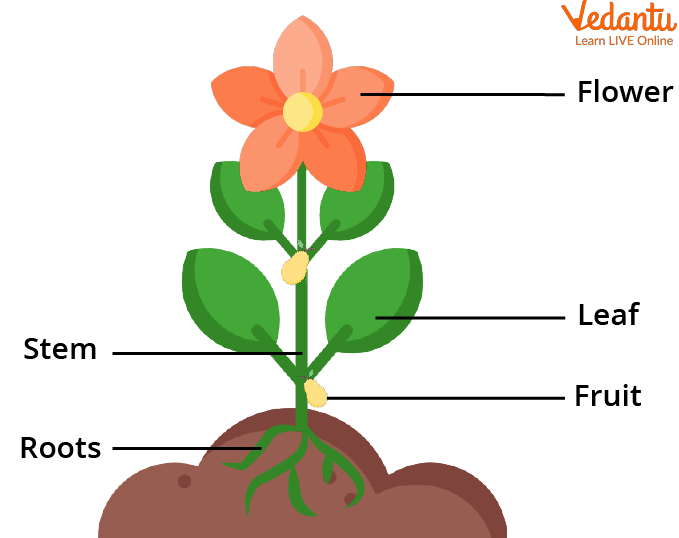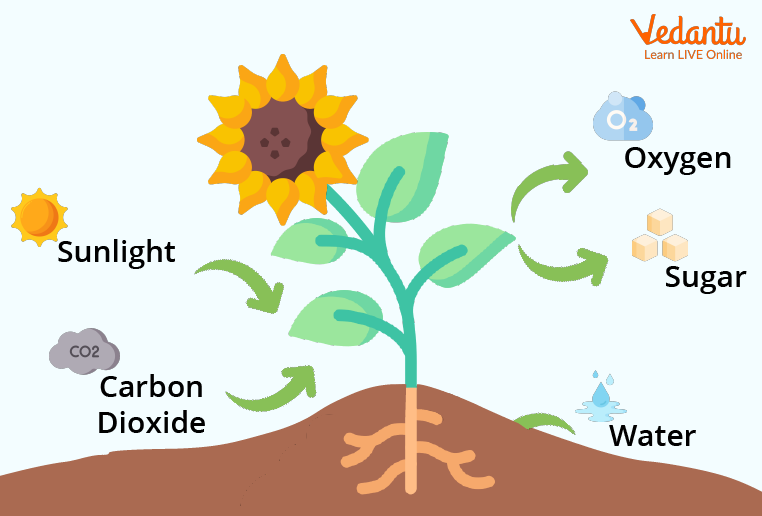




Step-by-Step: The Plant Growth Process Explained for Kids
Have you ever wondered how a small seed turns into a new plant? We will discuss the whole process of how plants grow in great detail. We will also study the parts of the plants.
A plant is a living thing that grows in the ground after the seed is sowed. It has a lot of leaves coming out of the stem and branches. A plant also has flowers and fruits in it which are very useful in nature. The plant also has roots through which they get water and other minerals from the ground.

A Plant
A plant contributes to nature in a lot of ways. It gives oxygen to all living organisms. A plant keeps the environment clean and beautiful. Plants provide fruits, flowers, and green leaves to animals and humans.
Plants also make their own food through the photosynthesis process. Plants can also be grown in water bodies such as lakes, rivers, seas, ponds, and oceans. Plants are an important part of the ecosystem as well.
What is a Seed?
A seed is sown inside the ground and is the embryo of the plant. The process of seed development is also called germination. Through the process of germination, the embryo sprouts with the help of water and soil and grow into small stems, roots, and leaves. The process leads to the sprouting of the embryo which is the first step toward the growth of a plant.
How Do Plants Grow?
After the process of germination, the embryo will start sprouting into small leaves, roots, and a stem. The roots will then start spreading in the ground which leads to the growth of the plant.
The roots absorb water and minerals, and then the stem starts growing. With the help of the sunlight, the stem grows in branches. Green leaves start growing out of the branches. The five things plants need to grow are sunlight, water, minerals, and food. With the passage of time, fruits and flowers start growing, and the plant grows fully.
The Process of Photosynthesis
The process through which plants make their own food is called Photosynthesis. The plants use sunlight to make food. They take carbon dioxide and release oxygen into the air. All humans and animals use oxygen for breathing purposes while humans do the opposite. This whole process is called the process of Photosynthesis.

Photosynthesis
Fun Activity for Kids
To see how a plant grows, an activity can be performed by the kids at their home. Through this activity, all the kids will understand the facts on plants and their importance.
Take a pot or glass and clean it properly.
Take some seeds of any plant that are easily available.
Put some soil in the pot, along with the seed, and water it properly.
Don’t forget to water it at the proper times.
After some days you will witness a sapling with a small stem.
The stem will then grow into branches and leaves will start coming out.
Along with green leaves, you will see buds and flowers growing from the plant.
Your plant is ready to be decorated in your balcony.
This activity can be performed individually or the plant can also be brought to school where it can be decorated in the class. Through this, all kids will understand the importance of growing plants. Kids can also water them regularly.
Fun Facts About Plants
We, human beings, use more than 2000 different types of plants to create various delicious food items in our meals.
Bamboo is an extremely rapid-growing plant. In fact, some bamboo varieties can grow almost a metre (about 3.2 feet) in a single day.
Caffeine works as a pesticide in a coffee plant.
Apple’s volume consists of 25% air, which is why it floats on water.
More than 85% of plant life is found in the ocean.
Poison Ivy produces a skin irritant known as Urushiol, which can cause an allergic reaction like an itchy rash on the exposed skin.
Many plants are carnivores like the Venus Flytrap and eat tiny little insects and spiders to gain useful nutrients.
In order to help plants to grow, fertilisers are added to the soil or sprayed on them. Manure, which is actually animal waste, is a fertiliser too.
Ginkgo Biloba, which dates to about 250 million years ago, is the oldest living tree species in the world.
Banana is actually an Arabic word for fingers.
Summary
The journey of the seed to become a plant is inclusive of Science facts about plants. In the plant’s life, the process of germination takes place which is responsible for a plant’s growth. They also make food through the process of photosynthesis. Through all of this, a plant grows fully with leaves, flowers and fruits on it. All living beings are dependent on plants.
FAQs on How Do Plants Grow?
1. What are the uses of a plant? Describe any five main uses.
A plant is an important part of the ecosystem.
Plants give us flowers and fruits, which can be used by humans and animals.
Plants also give us oxygen, which all humans, animals, and birds breathe.
Plants also keep the environment safe and clean.
They also add beauty to the environment.
Thus, plants are our friends and we should grow more and more plants.
2. What if all plants died?
Human beings and other animals need plants to live. When green plants make food, they give off oxygen. This is a gas that all animals need to breathe in order to stay alive. Without plants, animals would have no oxygen to breathe and would die.
3. Do we need plants to breathe?
Photosynthesis and respiration are the two essential processes that allow life to sustain on earth. In a way, they are a cycle — plants help humans breathe by providing us with oxygen, and humans help plants "breathe" by providing them with carbon dioxide.
4. Which country has the most trees?
As per the figures published in Nature Journal, Russia is the world's tree leader with 642 billion trees, followed by Canada (318-361 billion trees), Brazil (302-338 billion), the United States (222-228 billion), and China (140-178 billion).
5. Which is the biggest forest in the world?
The Amazon is the world's largest rainforest. It's home to more than 30 million people and one in ten known species on Earth.









